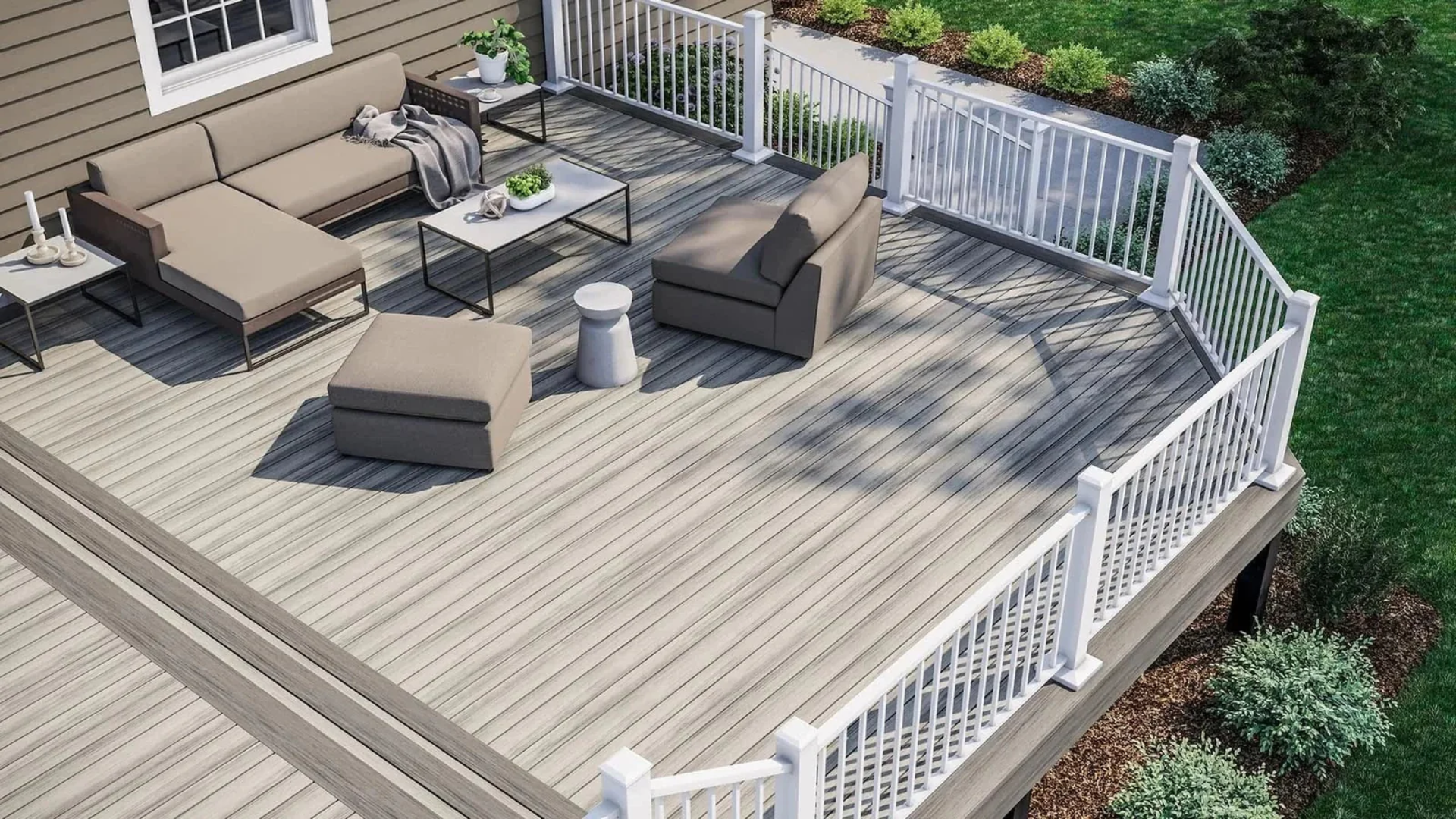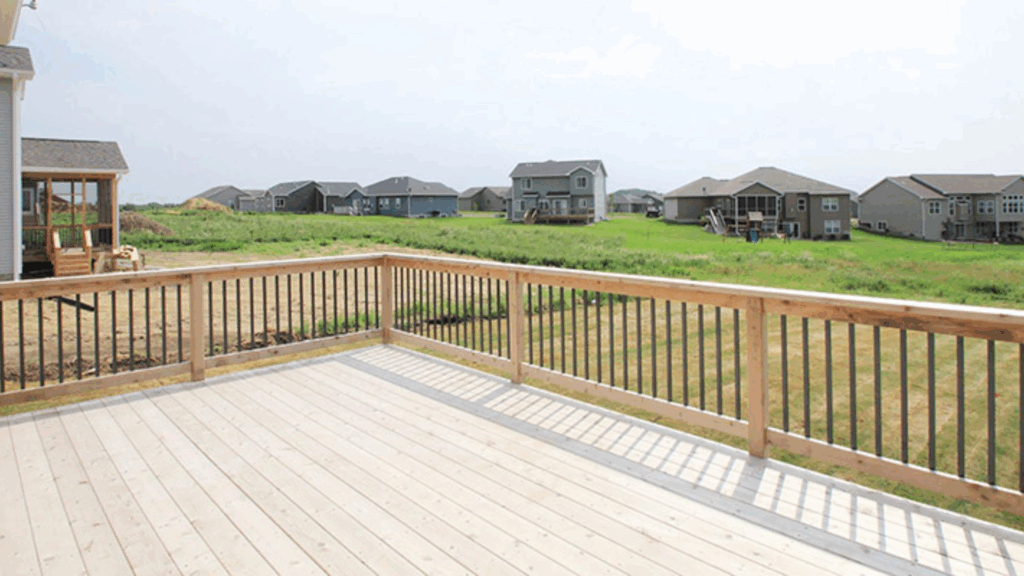I’ve always enjoyed being outside, and adding composite decking to my space made it even better. It gave me a clean, low-maintenance spot to relax and spend time with family.
When the weather warmed up, I noticed how hot the deck got in direct sun, sometimes even hotter than wood.
That made me curious about what causes it. So, I started looking into what affects deck temperature, how composite compares to other materials like PVC, and what changes I could make to stay more comfortable.
In this blog, I’ll walk through what I learned, how things like board color, texture, and sun exposure all play a role.
I’ll also share a few simple changes that helped cool things down on my deck.
If you’re thinking about composite decking or already have it, here’s what to keep in mind to enjoy your space all summer, without worrying about hot surfaces.
What Is Composite Decking?

Composite decking is a type of outdoor flooring made by mixing recycled wood fibers with plastic. This combination creates boards that look like real wood but need much less upkeep.
It doesn’t splinter, crack, or rot like traditional wood. It also resists mold, insects, and fading.
Some newer composite decks are designed with special caps or coatings that help reflect sunlight, which can reduce how hot the surface gets.
These features make it a great option for busy families or anyone who wants a long-lasting deck without the hassle of constant maintenance. No need to stain or seal it regularly like wood, and cleaning it is simple, just soap and water.
It’s tough, looks great, and stays easy to handle all year, making it ideal for low-maintenance outdoor living.
Do Composite Decks Get Hot in the Sun?
Yes, composite decking can get hot in the sun, especially during the hottest parts of the day. Like concrete, pavers, or traditional wood, composite boards absorb heat when exposed to direct sunlight.
The surface can feel quite warm underfoot, something to consider if you plan to walk barefoot on it.
Newer composite materials use heat-reflective caps and absorb less heat, making them cooler than older composites or dark wood decks.
Some brands now offer cooling technology and a wide range of lighter color choices that reflect sunlight better.
Deck temperature also depends on board texture and sun exposure. Textured or embossed boards allow more airflow, helping the surface stay slightly cooler.
Light-colored boards tend to reflect more sunlight and stay cooler than darker options, which absorb more heat. Even though composite decking can get warm, it’s usually no hotter than other typical outdoor surfaces.
With the right combination of material, color, and deck layout, you can build a space that feels much more comfortable, especially during the summer months.
Key Factors that Affect Deck Temperature
How hot your deck gets can make a big difference in comfort, especially in the summer. Several factors influence how much heat your deck absorbs and retains. This helps you choose better materials, colors, and layout.
- Color: Darker boards soak up more heat and get hotter than light ones.
- Material: Capped composites or PVC boards reflect sunlight better and stay cooler.
- Sun Exposure: Decks in full sun all day will heat up more than shaded ones.
- Airflow and Moisture: Good ventilation helps cool the deck faster after heating.
- Board Texture: Smooth surfaces retain more heat, while textured finishes cool quicker.
- Board Thickness: Thicker boards can hold heat longer than thinner ones.
- Surrounding Materials: Nearby brick or concrete can radiate extra heat onto the deck.
- Humidity Levels: High humidity can slow heat release, keeping the deck warmer.
- Time of Day: Late afternoon sun typically creates the highest surface temperatures.
- Geographic Location: Regions with intense sun or higher UV levels make decks hotter
How Hot Can Composite Decking Get?
On a sunny summer day, composite decking can get surprisingly warm.
Depending on the color, brand, and exposure to direct sunlight, the surface temperature may climb to between 110°F and 135°F (43°C to 57°C).
Dark-colored boards tend to absorb more sunlight and heat up faster than lighter ones. Decks in full sun for most of the day, especially those without shade or good airflow, can become too hot to walk on barefoot.
Some composite boards now feature heat-mitigating technology that reduces how much heat is absorbed or retained.
Compared to wood, composite materials may hold heat longer after sunset.
Knowing this can help with planning, choosing lighter colors, increasing ventilation, and using shade structures can all help reduce surface heat and make the space more enjoyable, even during hot weather.
Comparing Composite Decking with Other Materials
When compared to other decking materials, composite decking generally retains more heat than wood but offers superior durability and low maintenance.
| Decking Material | Heat Retention | Durability | Maintenance Needs | Visuals | Cost |
|---|---|---|---|---|---|
| Wood | Cools faster in the shade | Prone to splinters, warping, and fading | Requires frequent maintenance | Natural look, but can deteriorate over time | Moderate to low |
| Composite | Warmer in the sun, but cools faster than PVC | Long lifespan, resistant to the elements | Low maintenance | Mimics wood without the upkeep | Higher than wood but more durable |
| PVC | Gets hotter, especially in darker colors | Very durable, resistant to moisture | Low maintenance | Less natural, limited visual appeal | Higher than composite |
| Aluminum | Stays cooler in the sun | Extremely durable, resistant to corrosion | Low maintenance | Lacks natural wood appearance | Higher than composite and PVC |
Is Composite Safe for Bare Feet and Pets?
Composite decking can become quite warm under direct sun, especially in darker shades.
When surface temperatures rise above 120°F (49 °C), it can feel too hot for bare feet or pet paws, increasing the risk of burns or discomfort.
While most composite boards stay within safe limits, some may reach higher temperatures on peak summer days. Always test the surface before walking or letting pets out.
Choose shaded areas, rugs, or lighter-colored boards to help reduce surface heat.
Newer composite products often include cooling technology or reflective surfaces, making them more pet- and family-friendly. Still, caution is key; limit barefoot contact during the hottest times of the day.
For households with kids or animals, planning for shade, using mats, and selecting cooler materials can make your deck safer.
Tips for Reducing Heat Retention on Your Composite Deck

To reduce heat retention on your composite deck, choose lighter colors that reflect sunlight. Adding shade with structures like pergolas or umbrellas can also help reduce temperatures.
- Choose Lighter Colors: Light-colored composite decking reflects more sunlight, absorbing less heat than darker tones. This keeps the surface cooler and more comfortable in the sun.
- Add Shade to Your Deck: Install pergolas, umbrellas, or plant trees to block direct sunlight and lower deck temperatures naturally.
- Use Heat-Resistant Mats or Rugs: Place outdoor rugs or mats on high-traffic areas to reduce surface heat and protect bare feet.
- Add Greenery Around Your Deck: Use shrubs, vines, or tall plants to create natural shade and reduce heat absorption from direct sunlight.
- Consider Deck Ventilation: Ensure airflow under your deck by adding vents or spacing boards properly to help cool the surface.
- Use Decking with Heat-Resistant Features: Select composite boards with reflective or heat-reducing technologies for a cooler experience in sunny weather.
Conclusion
After installing composite decking, I quickly noticed how different materials and colors affect how hot the boards feel.
Darker options warmed up fast, while lighter shades stayed more comfortable, especially when paired with some shade.
When planning a deck, consider sun exposure and choose materials that stay cooler. You might find that capped composite or even PVC works best.
Don’t wait until summer heat makes your deck uncomfortable. Planning ahead now can save you from hot surfaces later. Feel free to reach out if you’d like help choosing the right materials.
I’m happy to share what’s worked for me and help you create a deck that stays cool and comfortable all year.

